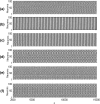Suppressing bursting synchronization in a modular neuronal network with synaptic plasticity
- PMID: 30483370
- PMCID: PMC6233333
- DOI: 10.1007/s11571-018-9498-9
Suppressing bursting synchronization in a modular neuronal network with synaptic plasticity
Abstract
Excessive synchronization of neurons in cerebral cortex is believed to play a crucial role in the emergence of neuropsychological disorders such as Parkinson's disease, epilepsy and essential tremor. This study, by constructing a modular neuronal network with modified Oja's learning rule, explores how to eliminate the pathological synchronized rhythm of interacted busting neurons numerically. When all neurons in the modular neuronal network are strongly synchronous within a specific range of coupling strength, the result reveals that synaptic plasticity with large learning rate can suppress bursting synchronization effectively. For the relative small learning rate not capable of suppressing synchronization, the technique of nonlinear delayed feedback control including differential feedback control and direct feedback control is further proposed to reduce the synchronized bursting state of coupled neurons. It is demonstrated that the two kinds of nonlinear feedback control can eliminate bursting synchronization significantly when the control parameters of feedback strength and feedback delay are appropriately tuned. For the former control technique, the control domain of effective synchronization suppression is similar to a semi-elliptical domain in the simulated parameter space of feedback strength and feedback delay, while for the latter one, the effective control domain is similar to a fan-shaped domain in the simulated parameter space.
Keywords: Bursting synchronization; Modular neuronal network; Nonlinear delayed feedback control; Synaptic plasticity.
Figures










Similar articles
-
Delayed feedback control of bursting synchronization in a scale-free neuronal network.Neural Netw. 2010 Jan;23(1):114-24. doi: 10.1016/j.neunet.2009.08.005. Epub 2009 Aug 20. Neural Netw. 2010. PMID: 19726157
-
Chaotic phase synchronization in a modular neuronal network of small-world subnetworks.Chaos. 2011 Dec;21(4):043125. doi: 10.1063/1.3660327. Chaos. 2011. PMID: 22225362
-
Modeling of synchronization behavior of bursting neurons at nonlinearly coupled dynamical networks.Network. 2016;27(4):289-305. doi: 10.1080/0954898X.2016.1249981. Epub 2016 Nov 10. Network. 2016. PMID: 27830974
-
Suppression of chaotic bursting synchronization in clustered scale-free networks by an external feedback signal.Chaos. 2021 Aug;31(8):083128. doi: 10.1063/5.0056672. Chaos. 2021. PMID: 34470231
-
How synaptic plasticity influences spike synchronization and its transitions in complex neuronal network.Chaos. 2018 Aug;28(8):083120. doi: 10.1063/1.5038593. Chaos. 2018. PMID: 30180622
Cited by
-
Influence of inhibitory autapses on synchronization of inhibitory network gamma oscillations.Cogn Neurodyn. 2023 Oct;17(5):1131-1152. doi: 10.1007/s11571-022-09856-5. Epub 2022 Aug 12. Cogn Neurodyn. 2023. PMID: 37786650 Free PMC article.
-
Effect of internal and external chaotic stimuli on synchronization of piezoelectric auditory neurons in coupled time-delay systems.Cogn Neurodyn. 2024 Aug;18(4):2111-2126. doi: 10.1007/s11571-023-10042-4. Epub 2023 Dec 1. Cogn Neurodyn. 2024. PMID: 39104671 Free PMC article.
-
Epileptic seizures in a heterogeneous excitatory network with short-term plasticity.Cogn Neurodyn. 2021 Feb;15(1):43-51. doi: 10.1007/s11571-020-09582-w. Epub 2020 Mar 16. Cogn Neurodyn. 2021. PMID: 33786078 Free PMC article.
-
The beta oscillation conditions in a simplified basal ganglia network.Cogn Neurodyn. 2019 Apr;13(2):201-217. doi: 10.1007/s11571-018-9514-0. Epub 2018 Dec 4. Cogn Neurodyn. 2019. PMID: 30956724 Free PMC article.
-
Interaction of Indirect and Hyperdirect Pathways on Synchrony and Tremor-Related Oscillation in the Basal Ganglia.Neural Plast. 2021 Mar 13;2021:6640105. doi: 10.1155/2021/6640105. eCollection 2021. Neural Plast. 2021. PMID: 33790961 Free PMC article.
References
-
- Boccaletti S, Kurths J, Osipov G, Valladares DL, Zhou CS. The synchronization of chaotic systems. Phys Rep. 2002;366:1–101. doi: 10.1016/S0370-1573(02)00137-0. - DOI
LinkOut - more resources
Full Text Sources

